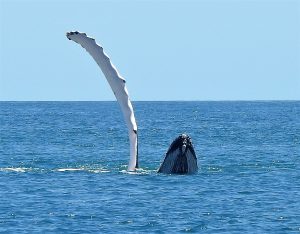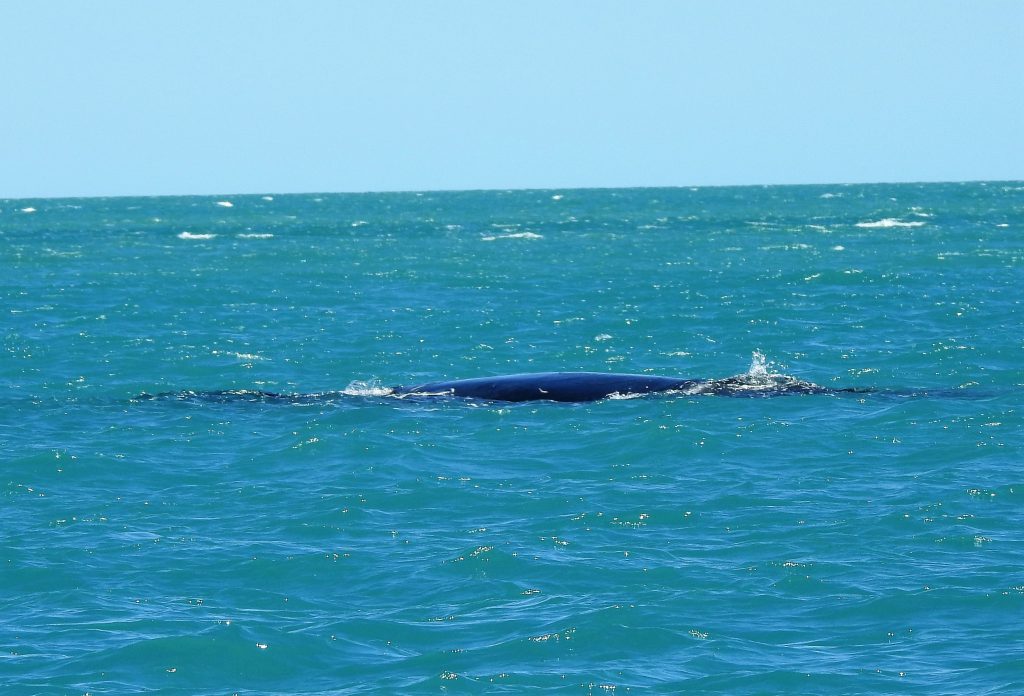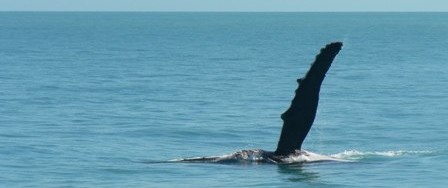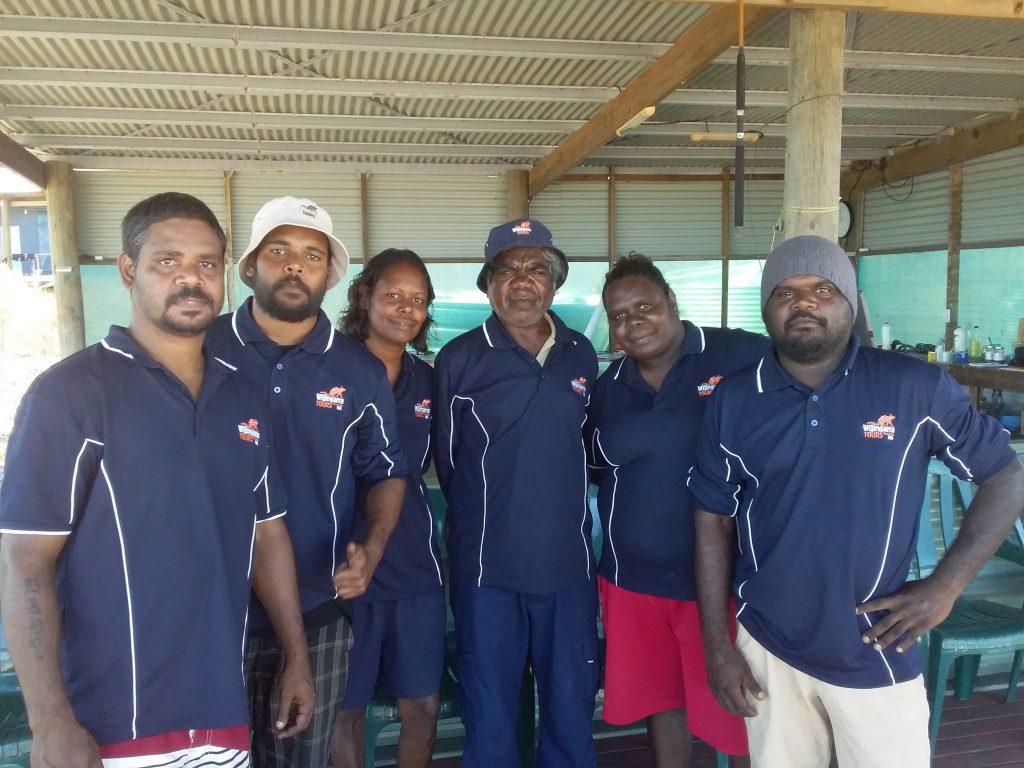What a joy the whales that visit Lulim continue to be. This year was no exception of steady use of the waters in and around Lulim to give birth, wean, train, and socialise as mother and infant, and as social groups, preparing to return to Antarctica.
The first of our sightings may, according to anectdotal evidence, have been one of the first for the year in this area of the Lalang-Garram marine park, and it was on welcome as the Arraluli clan returned to the camp for the season in late June.
The whale use of the area was steady for the season through to September when the survey was closed.
This year the project spent substantially more time on the water, with regular passage from Freshwater Cove through to Doubtful Bay. Surveys were also conducted around the Hall Point area, and in the inshore areas up to south west Augustus.
We also witnessed for the first-time activity of whales close up in and around west side of the Montgomery Islands.
 Our survey activity remains concentrated around the use of the corridor north and south inshore Montgomery from Doubtful Bay to Hall Point.
Our survey activity remains concentrated around the use of the corridor north and south inshore Montgomery from Doubtful Bay to Hall Point.
We weren’t disappointed with a steady number of mothers and infants sighted directly off the camp observation position in the last week of June and through to the second week of September.
Some great interactions were had throughout country this year.
In one encounter, a lost infant was again re-united with its mother off High Cliffy Islands, captured on video by our crew.
In another, a group of up to five adults swum and dove energetically around a heavily pregnant female slowly moving to a sacred tribal water that is also known to be an area used by whales.
The range of behaviours was consistent with previous years’ observations, but we find each interaction each year also has its own variance and personality.
Natural reef formations around Wijingarra areas that have been noted in the past as significant guides for whale navigations, continued to be high activity areas.
We also observed a lot of activity at Foam Passage, in and out of Doubtful Bay, with regular mother and calf sightings.
 Surveyed numbers appeared slightly less activity than last year, but we used some differing survey approaches and did not have a consistent sample period.
Surveyed numbers appeared slightly less activity than last year, but we used some differing survey approaches and did not have a consistent sample period.
Several stages of birth observed in the inshore areas and bays between Doubtful Bay and Lulim Island, show that this continues to be an area for quite late pregnancies, where mothers often spend some time giving birth in shallower waters, where one was observed breaching just prior to going into final labour.
Overall Arraluli areas continued to be utilised by the humpbacks, or mundumbun as we call them, as a maternity ward, nursery, meeting and staging point. The presence is undeniable in the bays and inshore and island waters for more than 3 months it would appear from our recordings over the past 6 years. It may be more.
 Caption: Mother inshore Lulim waiting to give birth.
Caption: Mother inshore Lulim waiting to give birth.
Vale to more friends of the project – Michael Edols
The project and the Arraluli clan were sad to farewell good friend and filmmaker Michael Edols this year. Michael filmed two movies in Lulim, with the second (When the Snake Bites the Sun) featuring current Traditional Owner Isobel Peters’ mother Amy.
 Isobel had retained a strong connection with Michael after catching up with him in northern Sydney for the first time since she was a child and appeared in a third Edols movie filmed in and around Derby.
Isobel had retained a strong connection with Michael after catching up with him in northern Sydney for the first time since she was a child and appeared in a third Edols movie filmed in and around Derby.
The news of his passing came to us in country in the very areas he so fortuitously captured at the behest of the elders, documenting the land and waters as well as the complex social relationships that go with family, culture and country. In traditional Worrora fashion, a shooting star was observed the evening prior to receiving the news. Our thoughts go with Michael, his beloved wife Marion and his family, and of great times shared, and future times that will not.
One of Michael’s favourite lines after re-igniting his contact with country through Isobel, was “I am glad to have a skin relationship again.” Michael was referring to his tribal relationship to Isobel, which in skin system was father, given to him in the ceremony filmed in When the Snake Bites the Sun. Michael’s efforts for our family and tribe will always be remembered.
This picture is of Michael and Isobel.
Rock art – busting the mystery myth
Presence in country including guided tours to land sites in Arraluli areas, brings with it engagement with opinions and questions about the rock art in our country.
Firstly, these are places that are sacred and unique to us, we have stories for them, and we know how they place in our culture, and inside wider human culture. Secondly, the idea of a mystery race is a myth masked by pseudo-science and selective and abstract referencing coupled with stark and strategic omissions. In short, the theories of the mystery race are offensive on cultural as well as scientific grounds. This is not just the view of the Arraluli clan. It was the positions of the elders winning Native Title, and a position conferred by many academics including the Australian Archaeological Association.
The Arraluli-Worrora cosmology and history is supported by numerous studies across disciplines.
Bradshaw art is known as Gwion (Guyon) and elders created a specific educational product in the book Gwion Gwion to address the lack of recording and availability of their rich connection to all the rock art in the Kimberley, including these very old images in our coastal areas.
We suggest as a starting point that people access this book and understand the explanations of the elders of the culture contained in the ‘rock art’, and how it is special to the foundations of our culture, a culture recognised by the Australian Government, and that is not under any identity dispute.
We also encourage you to view this clip and associated notes put together in 2001 for public viewing and education where one of our senior lawman from the Ngarinyin tribe, representing all our culture, explains what Wandjina and Gwion are, and how we three tribes are connected to them through law and culture. We cannot say it better than this. Nor should we try.
https://aso.gov.au/titles/tv/message-stick-scotty-martin/clip2/
A new venture supporting whale surveys
In response to demand for coastal tour charters to access cultural sites in country, this year Isobel’s family started Wijingarra Tours. With the support of Dambimangarri Aboriginal Corporation, Tourism WA, the Western Australian Indigenous Tourism Operators Council (WAITOC) and Morrgul.
“We are following the model that was put together at Bush University by our elders before they died,” Isobel says.
“By talking to almara (strangers) in country, that is the way we can teach what our law and culture is. It has always been that way, and that’s why they taught us to do it this way, through tourism.”
The family staff that make up Wijingarra Tours – Isobel’s sons Neil and Bart, daughter Naomi, and fellow Worrora tribe members and close family Neville, Ishmael and Kerrieanne – spent time in between travelling to tours, and from base camp viewing points in downtime, conducting the whale surveys, with special mention to Naomi and Kerrianne for their work capturing early season interactions off base camp, Bart for driving the boat, and everyone contributing to the survey.
Photo caption: (left to right) Neil, Bart, Naomi, Neville, Kerrianne and Ishmael.


